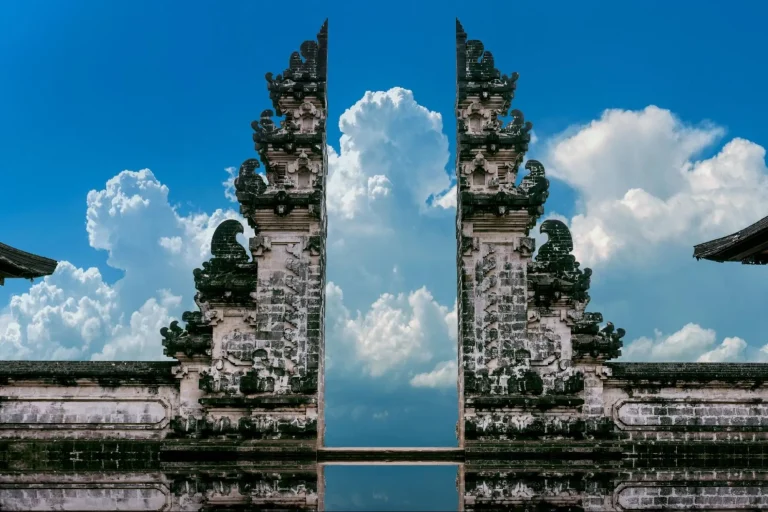Exploring Bali: Beyond the Tourist Hotspots
14 February 2024

Nusa Penida
We’ll start on the little Island of Nusa Penida, located southeast of the mainland of Bali. This island boasts incredible landscapes and a vibrant marine life.
Depending on how strapped for time you are, even a day trip here is worthwhile just to see the beaches. For example, Kelingking Beach is an extremely popular tourist attraction due to its astounding views. But keep in mind, it’s a steep climb down to the beach, so you’ll need to be fit, and getting back up is even harder! For a more traditional beach experience, go to Crystal Bay, where you can swim in clear waters, or even go snorkelling and experience marine life.
For another great beach experience, head across to the bottom of mainland Bali, to Gunung Payung Beach. This is more for people with a little time on their hands, but it’s well worth it! One of Bali’s so-called “hidden beaches”, it requires a 30 minute drive from Kuta, and even when you’re there, you’ll have to climb down 300 steps to reach the beach. The positives: it’s usually fairly vacant, and it’s great for snorkelling. You won’t find any shops, so be sure to bring your own food and water, and be careful when swimming; there are no lifeguards, but lots of spiny sea urchins.
Gianyar Regency
Moving further into the mainland, we find ourselves in Gianyar.
Bali has a number of beautiful waterfalls, and you’ll absolutely want to take a look at the Kanto Lampo waterfall. You’re best advised to take swimwear, because you’ll get the best views of the waterfall from the river. Like many landmarks in Bali, you have to be careful; the path is slippery and there are a lot of sharp rocks along the way, so wear some sturdy shoes! And be sure to carry a map. The reception can be a little dodgy.
Ubud is known as the art capital of Bali, having attracted all kinds of artists overseas over the last century. You will find multiple museums that house expansive collections of works from Bali’s most influential artists. In the evenings, there are performances of traditional art and dance. Take a look at Lempad House – Bali’s oldest art museum – that was once home to I Gusti Nyoman Lempad, a highly revered local artist. His work has strongly influenced the art style practised in Bali to this day.
You can then take a very short stroll to the Seniman – a coffee shop with great coffee, but also some quirky, arty decor.
Now on to Tegallalang, and Bali Funtastic is an excellent destination for families. The restaurant is in a lovely location that allows for views of the beautiful rice fields but has some excellent food, both Indonesian and international. They can house up to 150 people, and are very open to event bookings.
Still in Tegallalang, and you’ll need somewhere to stay. Where better than the Elephant Safari Park Lodge? Whilst the accommodation itself is fairly unremarkable, the opportunity to interact with elephants has made this into an extremely popular destination. You’ll have the opportunity to feed, bathe and swim with the elephants, or take a scenic and fun elephant safari ride. They’ll even pick you up and take you to dinner!
East Bali
Known also as Pageringsingan, Tenganan is an ancient village located in the regency of Karangasem. It is home to one of the Bali Aga – those Indigenous to Bali – and is famous for the way it has managed to preserve its village layout and traditional crafts. You can take tours, where locals will explain the history to you. If you happen to be there in June, time your visit to see the Perang Pandan, a traditional Balinese ritual combat that honours the Warrior God, Indra.
If you’re looking for a spiritual experience while in East Bali, visit Tirta Gangga. This was once a royal palace, built in 1946 by the King of Karangasem, but largely destroyed by a volcano eruption in 1963. These days it is largely restored, and still has religious significance. Hindus bring holy water to the Patirthan Temple, making it an important pilgrimage for many Balinese locals, 87% of which are Hindu. It is also a beautiful place for tourists to visit, as the water garden – which incorporates traditional Balinese sculpture and designs, is an absolute sight to behold.
Pemuteran
Very much one of Bali’s hidden gems, Pemuteran is a peaceful, quiet rural place in northwestern Bali. You can spend time in Pemuteran snorkelling, diving and relaxing on their relatively empty beaches, making it quite a contrast to what we usually associate with Bali. In fact, it usually takes very little effort to find a stretch of beach entirely bereft of people, and you’ll even be able to find black sand. Be careful where you swim; certain areas have a lot of rocks.
It is a good idea to have a look around the town. This is a very different place to the more tourist-oriented parts of Bali. You’ll find cafés, spas and family-run shops, as opposed to the chaotic markets and boutique souvenir shops more often associated with the island. You would be well-advised to stay at a hotel with a pool, because Pemuteran gets extremely hot.
West Bali
The Bali West National Park is a wonderful destination for those wanting to experience the wildlife of Bali. If you go trekking in the Evergreen Forest, you’ll likely see all kinds of different birds, as well as black monkeys and giant squirrels. You can book a combined bird watching and safari tour with Idris, a popular local tour guide. You also have the option to go on boat tours and do some jungle cycling. If you’re lucky, you might see a crested serpent-eagle, a large flying fox or even a water monitor.
Moving around 10 kilometres northwest of the Bali mainland, our journey concludes on Menjangan Island. With white sands and natural beauty, this is the premier international diving location in Bali. The island is surrounded by coral reefs and its waters are inhabited by sea turtles, angelfish, batfish, tuna, and the occasional shark.
There are many great diving locations around the island, but perhaps the most interesting is the Anker Wreck Dive. Best for experienced divers, it is an old wooden ship wreck that sits on the seafloor on the western tip of the island. It lays around 45 to 50 metres below the surface. There is no certainty as to what this ship is: believed either to be a 19th century Dutch ship that sank during the Second World War, or possibly one that sank during the much earlier Dutch colonial era that was carrying Balinese slaves. Either way, the now coral-infested formation is a fascinating sight.
Conclusion
If you’re planning a trip to Bali, we’re sure we’ve given quite a lot to think about. Yes, the tourist hotspots are fun, but they barely scratch the surface of what the gorgeous island has to offer. Don’t forget to grab a prepaid card, loaded with e-Pocket for easy local spending and currency transactions.




